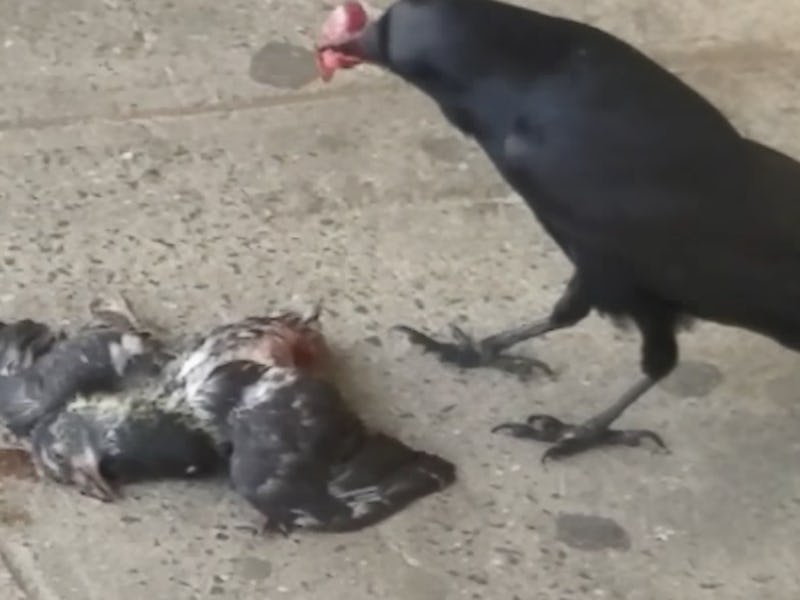Nowhere is the biological paradigm “survival of the fittest” better illustrated than it is in New York City. Passengers at Kings Highway Station saw the law of nature in action on Monday when they witnessed a massive black crow feasting on the guts of a flailing, gore-covered pigeon. The macabre scene was captured in a viral video that tracked the crow’s efforts to scatter its victim’s entrails across the subway platform. The crow succeeded, with aplomb; it congratulated itself by pecking out the pigeon’s still-beating heart — the bloody cherry on top of a sumptuous meal.
“New York City, it’s either eat or get eaten,” the video’s narrator, who mistakes the crow for a raven, says. “He just ate his homie! Damn.”
While it’s easy to label the crow a demonic cannibal-murderer, crow expert Kaeli Swift, a University of Washington Ph.D. candidate studying corvid thanatology — crow death — tells Inverse not to be so hasty. While the situation certainly casts the crow in a homicidal light, she points out, we don’t actually know what the pigeon’s deal was before the crow got to it. She suggests the crow might in fact be innocent, because the pigeon was already dead.
“I would be more surprised if the crow killed the pigeon,” Swift says in an e-mail. “My guess is it had a run in with a train or particularly unpleasant person.” Cornell University veterinary pathologist Dr. Beth Buckles, DVM, supporting Swift’s theory, adds that “If it had been alive there would have been a blood spurt.” The pigeon’s panicked twitching, she points out, was probably due to residual nerve activity.
Our sympathy for the pigeon shouldn’t distract us from the fact that they, too, can be nasty. “In my experience, adult pigeons can hold their own against crows and I’ve even seen them chase crows away from food,” says Swift.
Murder charges aside, it’s the crow’s cannibalistic behavior that really has New Yorkers freaked out. But Swift is nonplussed. “Nothing about this behavior strikes me as particularly unusual,” she says, in spite of one particularly gruesome scene where the pigeon’s intestines stretch out before it, like a blood-slimed leash. “Although eating carrion or active predation make up only a minority of an American crow’s diet, they take what they can get.”
The pigeon was likely injured or dead before the crow got to it, Swift point out.
Crows are considered omnivores, which means they’ll pretty much eat anything: small mammals, reptiles, eggs, seeds, fruit, and yes, other birds. They are also known to scavenge — a technical term that biologists use to describe animals that eat dead animal flesh, not garbage. If a fresh meal presents itself to a crow, especially in the middle of New York’s food desert, that crow is unlikely to let it go to waste. “Taking advantage of weak animals is also not unusual, and why they have such a vitriolic relationship with sheep farmers,” Swift points out, referring to reports of crows descending upon farms to devour baby sheep.
Getting to the heart of the matter.
“Not a particularly pleasant way to go but wild animals aren’t here to appeal to our moral sensibilities,” says Swift. “They’re just here, doing their badass thing whether we find it awesome or awful.”
On second watch, the crow’s behavior doesn’t appear any less brutal, but the relish with which it feasts on the mutilated pigeon corpse may stir up familiar sensations. As it triumphantly plucks out its prize — the pigeon’s ruby heart (it might actually just be a gizzard)— and thoughtfully considers it, you might recall how it feels to contemplate a fine slice of tuna sashimi, or a ripe heirloom tomato, before surrendering it to your lips. That feeling is what binds humans, crows, and all of our animal brethren; the one true law of nature — hunger.
